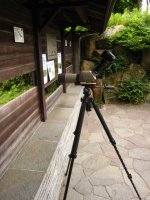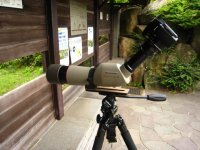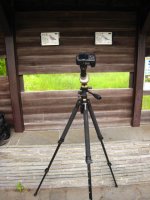I'm thoroughly confused on what to buy for digiscoping. I have a Canon 40D camera and would like to purchase a scope to take bird photos. However, the more I read, the more I don't understand about adapters, eyepieces and everything else. My budget for a scope is in the $1000 to $1500 range. I've looked at some Nikons, but am open to any suggestions the more experienced members can offer.
Hi Jake -
I suggest going through that entire thread that Paul linked to in his reply above. That is an excellent resource on digiscoping with DSLRs and IMO, should be pinned on the forum. I have just gone through this entire exercise over the past few days and can summarize my findings for you (keep in mind this is just the results of my research and not my personal experience - I am still in the decision-making stage myself, like you):
Generally speaking, there are 3 ways to shoot with your DSLR and a scope:
- Prime Focus: DSLR coupled to scope without eyepieces or lenses, but using teleconverters, barlows (an astronomic teleconverter) and extension rings to increase magnfication, as needed. This is the approach that has been yielding some of those great images that Paul and others are pioneering at ridiculous magnifications.
- Afocal coupling: this is the typical digiscoping method, and involves attaching a DSLR+lens to the eyepiece of the scope
- Eyepiece projection: here, the eyepiece is moved around to project a magnified image on the DSLR sensor
Click on this link and then click on "Imaging Methods" for more info:
http://www.televue.com/BirdScope/images/index.htm
The most common methods are the first 2.
You can do prime focus with scopes - simply buy a scope, the manufacturer's matching adapter for attaching a DSLR and you're off. But 2 caveats: 1/ You are going to be locked into a fixed system without a lot of flexibility and 2/ as Rick said, you may have compatibility issues with using a Canon DSLR with Nikon or Pentax DSLR adapters.
Also, I gather that the prisms of scopes introduce another element in the optical path which degrades quality. By all accounts, astronomical scopes do provide better image quality than birding scopes, albeit at the cost of weight and waterproofing (which, to me as a photographer who traipses around with a 500, a 100-400, a Gitzo 1548 tripod, a Wimberley head and a couple of bodies, is a non-issue).
So your other option is to use a system which allows you a degree of standardization and flexibility - an astro setup. Astro eyepieces come in standard 1.25" mounts. Some of them are pre-threaded to accept cameras (eg, Baader Hyperion eyepieces), while on others, you can clamp an adapter which provides a thread (CNCSupply makes these threads).
With these, what you do is as follows:
- attach a T-ring to the camera mount
- attach a T-adapter to the eyepiece
- pair the camera w/ T-ring to the T-adapter on the eyepiece and you're off to the races. You will need to add in some extension tubes in order to get the setup to focus, and also possibly teleconverters/barlows to boost the magnification.
Now you have a system where you can add/remove components, gain magnification, try all 3 methods mentioned above, swap eyepieces, etc. A very flexibile combo.
Of course, you will get best results with this setup if you put those eyepieces into an astro refractor telescope. You can also compromise and get a Pentax scope, which accepts 1.25" eyepieces and so allows you to build a flexibile system and retain some of the benefits of a traditional scope, although you'll find images are going to be somewhat better with a refractor (better optical design, no prism in between).
I have ended up settling on a Televue 85 setup, partly because of the great reviews it has gotten and also because image sales are an end-goal for the photos I plan to take with this rig. Were it strictly for personal use, I would have gotten the a WO Megrez 80 ($900) or the Skywatcher scope Paul mentioned.
Start at
www.cncsupply.com and check their T-ring section for more info. Then also visit alpineastro.com and see their section on Photography for more info on options.
Good luck with your search and ask away if you have more questions.
Vandit






